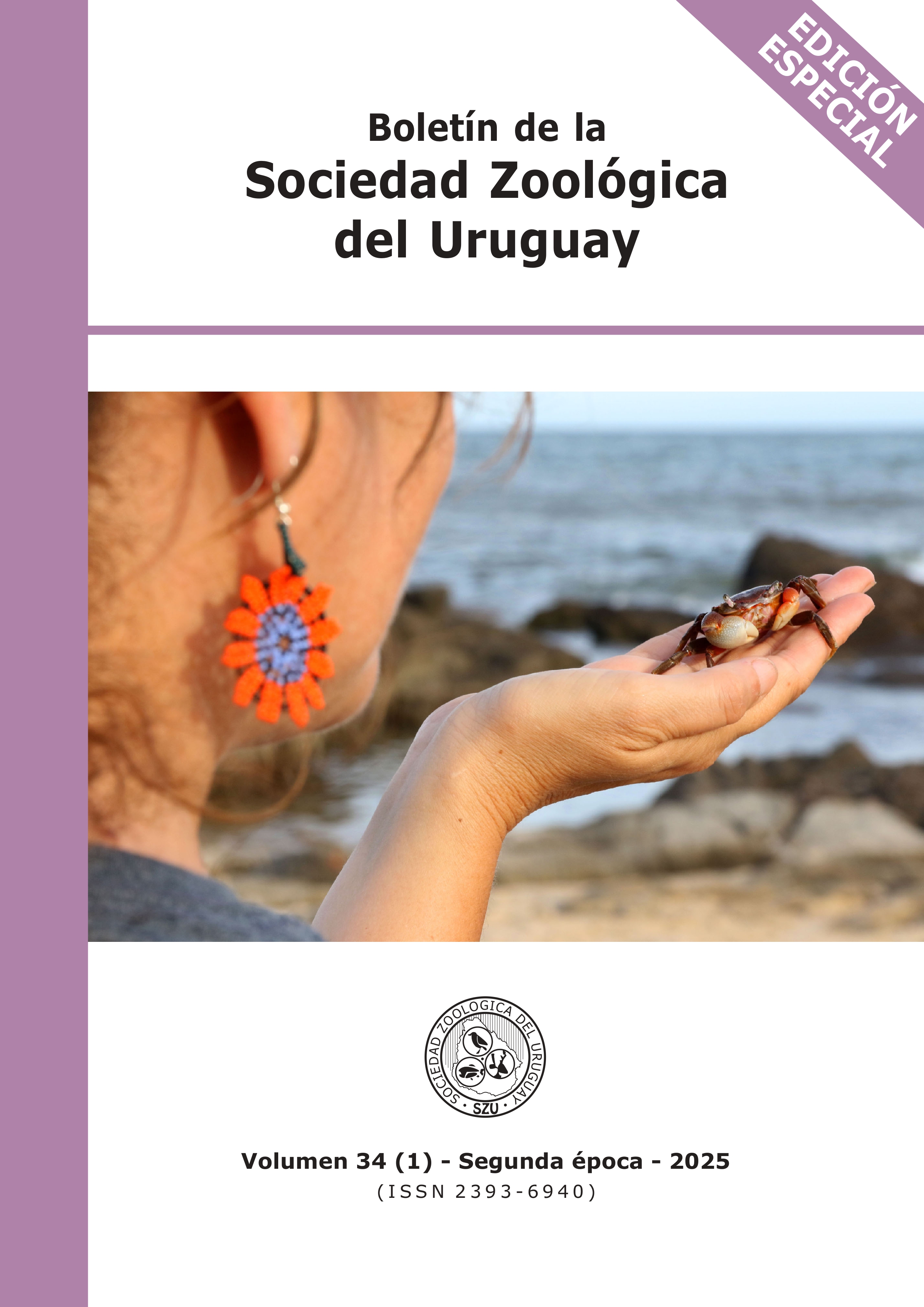ASIMETRÍA FLUCTUANTE EN INSECTOS TRIATOMINOS BRAQUÍPTEROS Y MACRÓPTEROS DE DISTINTO ORIGEN GEOGRÁFICO
DOI:
https://doi.org/10.26462/34.1.18Palabras clave:
Triatominae, Asimetría Fluctuante , morfometría geométrica, polimorfismo alarResumen
Triatoma guasayana es un insecto triatomino vector de Trypanosoma cruzi, agente etiológico de la enfermedad de Chagas. Este trabajo busca evaluar los cambios en la asimetría fluctuante (AF) de T. guasayana con polimorfismo alar (Braquíptero-Macróptero) como indicador de inestabilidad en el desarrollo con el fin de estimar posibles condiciones ambientales estresantes durante su morfogénesis. Se trabaja bajo la hipótesis de que el ambiente geográfico modifica la AF de cabezas, aunque ésta influencia puede variar en mayor o menor manera según la condición de braqui o macróptero. Se propone aquí, evidenciar si el ambiente geográfico o la condición alar son más fuertes en el desarrollo de asimetría fluctuante de cabezas. Se encontró que, en este triatomino, el ambiente de desarrollo como así también la condición alar (y posible actividad de vuelo) influyen en el desarrollo de AF de la conformación en cabezas. Machos y hembras evidencian diferencias en la magnitud y sentido del cambio encontrado en cuanto a la AF. Los resultados obtenidos resultan de importancia para comprender como el fenotipo de cabezas puede evidenciar el grado de adaptación al ambiente y su implicancia para el vuelo, en un triatomino vector de una parasitosis humana.
Descargas
Citas
Abrahan, L.B., Gorla, D.E., & Catalá, S.S. (2011). Dispersal of Triatoma infestans and other Triatominae species in the arid Chaco of Argentina: flying, walking, or passive carriage? The importance of walking females. Memórias do Instituto Oswaldo Cruz, 106(2), 232-239. https://doi.org/10.1590/s0074-02762011000200019
Beck, M.L., & Pruett-Jones, S. (2002). Fluctuating asymmetry, sexual selection, and survivorship in male dark-winged damselflies. Ethology, 108(9), 779-791. https:// doi.org/10.1046/j.1439-0310.2002.00814.x
Bookstein, F.L. (1992). Morphometric Tools for Landmark data: Geometry and Biology. Cambridge University Press.
Davidowitz, G., D'Amico, L.J., & Nijhout, H.F. (2003). Critical weight in the development of insect body size. Evolution and Development, 5(2), 188-197. doi: 10.1046/j.1525-142x.2003.03026.x.PMID: 12622736
Diotaiuti, L., Paula, O. R. D., Lima Falcão, P., & Pinto Dias, J. C. (1995). Avaliação do programa de controle vetorial da doença de Chagas em Minas Gerais, Brasil, com referência especial ao Triatoma sordida. Boletín de la Oficina Sanitaria Panamericana, 118(3), 211-219.
Dujardin, S., & Dujardin, J.P. (2019). Geometric morphometrics in the cloud. Infection, Genetics and Evolution, 70, 189-196. https://doi.org/10.1016/j.meegid.2019.02.018
Hernández, M.L., Espinoza, J., Gomez, M., & Gorla, D. (2020). Morphological changes associated with brachypterous Triatoma guasayana (Hemiptera, Reduviidae) and their relationship with flight. International Journal of Tropical Insect Science, 40(2), 413-421. https://doi. org/10.1007/s42690-019-00092-9
Klingenberg, C.P. (2015). Analyzing Fluctuating Asymmetry with Geometric Morphometrics: Concepts, Methods, and Applications. Symmetry, 7, 843-934. https://doi.org/10.3390/sym7020843
Klingenberg, C.P., McIntyre, G.S., & Zaklan, S.D. (1998). Left-right asymmetry of fly wings and the evolution of body axes. Proceedings of the Royal Society of London. Series B: Biological Sciences, 265(1402), 1255-1259. http://doi.org/10.1098/rspb.1998.0427
Klingenberg, C.P., Barluenga, M., & Meyer, A. (2002). Shape analysis of symmetric structures: quantifying variation among individuals and asymmetry. Evolution, 56(10), 1909-1920. https://doi.org/10.1111/j.0014-3820.2002.tb00117.x
Lent, H., & Wygodzinsky, P. (1979). Revision of the Triatominae (Hemiptera, Reduviidae), and their significance as vectors of Chagas disease. Bulletin of the American Museum of Natural History, 163, 408.
Nijhout, H.F., & Davidowitz, G. (2003). Developmental perspectives on phenotypic variation, canalization, and fluctuating asymmetry. Developmental instability: causes and consequences, 3-13.
Palmer, A.R. (1994). Fluctuating asymmetry analyses: a primer. In Developmental instability: its origins and evolutionary implications: proceedings of the international conference on developmental instability: its origins and evolutionary implications, Tempe, Arizona, 14-15 June 1993 (pp. 335-364). Dordrecht: Springer Netherlands.
Palmer, A. R., & Strobeck, C. (1986). Fluctuating asymmetry: measurement, analysis, patterns. Annual review of Ecology and Systematics, 391-421. https://doi.org/10.1146/annurev. es.17.110186.002135
Pérez-Ortega, J., Almanza-Ortega, N. N., Vega- Villalobos, A., Pazos-Rangel, R., Zavala-Díaz, C., & Martínez-Rebollar, A. (2020). The Kmeans algorithm evolution. Introduction to data science and machine learning, 69-90.
Rankin, M. A., & Burchsted, J.C.A. (1992). The cost of migration in insects. Annual Review of Entomology, 37, 533-559.
Rodríguez, M.H., & Ávila, D.D. (2015). Diferencias interespecíficas y geográficas en los niveles de
asimetría fluctuante en las alas de Erythrodiplax umbrata, Macrothemis celeno y Pantala flavescens (Odonata: Libellulidae). Poeyana, 501, 8-19.
Roff, D. (1990). The Evolution of Flightlessness in Insects. Ecological Monographs, 60, 389-421. https://doi.org/10.2307/1943013.
Schofield, C.J., Diotaiuti, L., & Dujardin, J.P. (1999). The process of domestication in Triatominae. Mem Inst Oswaldo Cruz, 94, 375-378.
Schofield, C.J., & Matthews, J.N. (1985). Theoretical approach to active dispersal and colonization of houses by Triatoma infestans. The Journal of Tropical Medicine and Hygiene, 88(3), 211-222.
Schweigmann, N., Vallvé, S., Muscio, O., Ghillini, M., Alberti, A., & Wisnivesky-Colli, C., (1988). Dispersal flight by Triatoma infestans in an arid area of Argentina. Medical and Veterinary Entomology, 2(4), 401-404. doi: 10.1111/j.1365-2915.1988.tb00215.x. PMID: 2980200
Soares, R.P.P. (1997). Aspectos Biológicos e Morfológicos Relacionados a Atividade de Vôo das Principais Espécies Vetoras da Doença de Chagas no Brasil, Tese, UFMG, Belo Horizonte, Brasil, 94 pp.
Soares, R.P.P., Dujardin, J.P, Schofield, C.J., & Diotaiuti, L. (1996). Wing symmetry and flight activity- fdi010007847- Memorias do Instituto Oswaldo Cruz, 1996, 91, p. 143 ISSN 0074-0276.
Vilaseca, C., Pinto, C.F., Órdenes- Claveria, R., Laroze, D., Méndez, M.A., & Benítez, H.A. (2022). Insect Fluctuating Asymmetry: An Example in Bolivian Peridomestic Populations of Triatoma infestans (Klug, 1834) (Hemiptera: Reduviidae). Symmetry, 14, 526. https://doi.org/10.3390/sym14030526 Nature, 150, 563- 565.
Waddington, C.H. (1942). Canalization of development and the inheritance of acquired characters. Nature, 150, 563- 565.
Waddington, C.H. (1957). The strategy of the genes. London: George Allen and Unwin. Wagner, D.L., & Liebherr, J.K. (1992). Flightlessness in insects. Trends in ecology & evolution, 7(7), 216-220.
Zakharaov, V.M. (1992). Population phenogenetics: analysis of developmental stability in natural populations. Acta Zoologica Fennica, 191, 7-30.
Zelditch, M.L., Swiderski, D.L., & Sheets, H.D. (2014). Geometric Morphometrics for Biologists: A Primer, 2a ed. Academic Press https://books.google.at/books?id=5DLZ4lALRTEC
Zera, A.J., & Denno, R.F. (1997-9. Physiology and ecology of dispersal polymorphism in insects. Annual Review of Entomology, 42, 207-30. doi:10.1146/annurev.ento.42.1.207. PMID: 15012313











